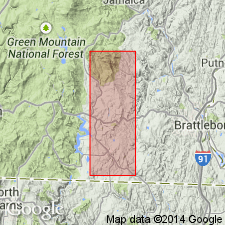
- Usage in publication:
-
- North River Igneous Suite*
- Modifications:
-
- Named
- Dominant lithology:
-
- Trondhjemite
- Amphibolite
- Gneiss
- AAPG geologic province:
-
- New England province
Summary:
Named the North River Igneous Suite for igneous rocks that intrude the Cram Hill Formation in VT. Unit consists of a massive gneiss unit (white to light-gray, well foliated to blastomylonitic, poorly layered, garnet-biotite-muscovite-chlorite-quartz-plagioclase granofels), quartz-feldspar granofels member (light-brown to tan, chlorite-ilmenite-muscovite-quartz-plagioclase granofels), the Blue Mountain facies (dark-gray to black, poorly layered, porphyritic and nonporphyritic, ilmenite-epidote-chlorite-plagioclase-hornblende amphibolite), the Whitneyville facies (light- to medium-green, massive, epidote-ilmenite-sphene-chlorite-hornblende-plagioclase amphibolite), and the West Halifax Trondhjemite (light- to dark-gray, coarse-grained, massive, ilmenite-chlorite-epidote-muscovite-quartz-plagioclase trondhjemite). The Blue Mountain and Whitneyville facies comprise a dike and sill complex. Rocks of the North River Igneous Suite are younger than the Cram Hill Formation and older than the Northfield Formation. The North River is of Ordovician and Silurian(?) age.
Source: GNU records (USGS DDS-6; Reston GNULEX).
For more information, please contact Nancy Stamm, Geologic Names Committee Secretary.
Asterisk (*) indicates published by U.S. Geological Survey authors.
"No current usage" (†) implies that a name has been abandoned or has fallen into disuse. Former usage and, if known, replacement name given in parentheses ( ).
Slash (/) indicates name conflicts with nomenclatural guidelines (CSN, 1933; ACSN, 1961, 1970; NACSN, 1983, 2005, 2021). May be explained within brackets ([ ]).

